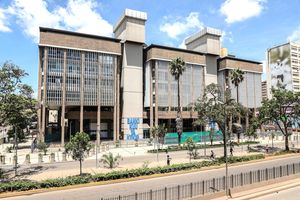
National Treasury Cabinet Secretary Njuguna Ndung'u.
Trying to project what is in store for us in 2024 is like being asked to do a jigsaw puzzle with only half a picture on the cover. This year is already awash with unknowns and variables: how far the Kenya shilling will drop is one; predicting the direction of the weather in this erratic era of climate change is another; how to deal with persistent inflation and the relentless rise in the cost of living is one more.
One way to look at where we are is to look back to those who dared such projections a month ago and how events have already overtaken many of their prognostications.
Let us look at the backdrop and some of the key movers and shakers in it. First of course is the weather. Kenya went through a succession of inadequate or deficient rainfall which hit the country negatively big time.
Much of our agriculture is rainfall generated or stimulated. Deficient rains lead to poor crops and sluggish agriculture which affects overall agricultural performance. Considering agriculture is still one of the foremost drivers of the economy any hiccups in the former automatically hit economic performance.
Basic food
Over the past couple of months, a lot of the country has been blessed with rain even in areas which are regarded as arid or semi-arid. This has helped the supply of our basic food maize and the assortment of other foods we eat.
The crops in a number of areas which are often deficient have been adequate. Thankfully, we have enough supplies of maize for the foreseeable future and if there are any shortfalls informal imports from our neighbours should make that up.
But maize, though very important is only part of our food equation. Kenya is a major importer of much of its wheat demand, a smaller but significant amount of its rice needs and even its beans and sugar. In short, it is a major food deficit nation.
And that is where it could get interesting, even crunchy, especially from the second and third quarter onwards if the next rains are in any way inadequate. What we import is going up in price and in fact, we are already seeing major price hikes of anything with imported content.
The exchange rate factor is obviously the driving issue here because if, when and as the shilling depreciates against major international currencies then we are paying more for our imported wheat, rice, beans barley and so on and that gets passed onto the consumer. The nasty thing with that it can often put further pressure on the shilling as we need to find more shillings for the relevant hard currency so the prospect of a further shilling downward spiral is real. So we all wait with bated breath to see if the next rains are going to be adequate or not.
Beyond that, we must take on board the global economic trends. One that has been with us for a while is inflation which has hovered around eight per cent or so. Worldwide, inflation has abated a little but is susceptible to geopolitical pressures. Another factor is debt payments and all eyes are on the next Eurobond payment midyear. In short, the country and the government are highly leveraged.
This leads us to the Middle East contagion and more specifically the Red Sea factor. Europe is a major trading partner for us and much of the surface transport goes through the Red Sea and Suez Canal. It is quick and cost-effective.
Take it out of the equation and one has a longer and more expensive journey around the Cape of Good Hope or more expensive air travel. As things stand much of the shipping has been diverted from the Red Sea route. Attacks may have reduced but there is still the uncertainty factor which looms and so major shipping companies will be wary of it for a while to come. It is worth remembering one is dealing with a guerilla group which is reasonably agile in an already volatile area and which is doing hit-and-runs on one of the world’s most vital shipping lanes.
It is not just shipping lanes. Air transport often uses a more circuitous route which inevitably increases costs. These uncertainties and diversions are costly and not only will we see supply chain disruptions but also significant price increases.
Kenya Ports Authority estimates that the cost of importing goods via the Cape of Good Hope will more than double freight costs and add around 34 days to a shipping journey. It is difficult to know how this is going to pan out but one thing is for sure is that the Middle East contagion is not about to go away and could easily impact our economic prospects this year.
In short, the external variables are there and will affect us one way or the other. There is also the issue of high voltage volatility. One minute the oil price goes up, then stabilises and even drops and at the moment it could go either way depending on what takes place globally and politically.
Indeed, there is the risk that it could go up, especially if certain key producers such as Saudi Arabia reduce the flows. Then we come to the domestic situation and equation. It is no secret that the majority of Kenyans are financially strapped and stressed especially with the rising cost of living and taxation. The Kenyan economic and social equation is increasingly charged and tense. It is not a Kenyan issue per se but is happening in many countries. The risk and level of social volatility are high and of course could get higher as and when food, fuel, transport and other prices rise.
Tax breaks
As stated Kenyans have a little respite in the price of maize and for the time being in pump prices but all the rest have been on the rise. How long the fuel price can remain where it is especially if world oil prices rise is an open question. Two things come out clearly from this. First, the government has a very unenviable task and is in between a rock and a hard place. Its weak financial position and base means it can hardly rush around with subsidies and tax breaks.
On the former, it is under pressure to reduce subsidies and increase taxes and the problem about the latter is that the law of diminishing returns kicks in. The more one taxes the disposable income that is left for consumer spending the more it puts brakes on the economy and commercial activity. The spectre of reduced activity all around becomes real.
Add into the equation import fuelled inflation, especially as a result of a shrinking shilling and the likelihood of ‘stagflation’ becomes real. Last but not least, this government is getting a reputation for weak financial management and profligacy, especially in matters pertaining to itself. It is fair to say the challenges it faces are Herculean and that said, it really needs to strengthen its grasp and management of the economy. The months ahead are going to be very trying and are likely to test both the government and the country as a whole.
Mr Shaw is an economic and public policy analyst:[email protected]











